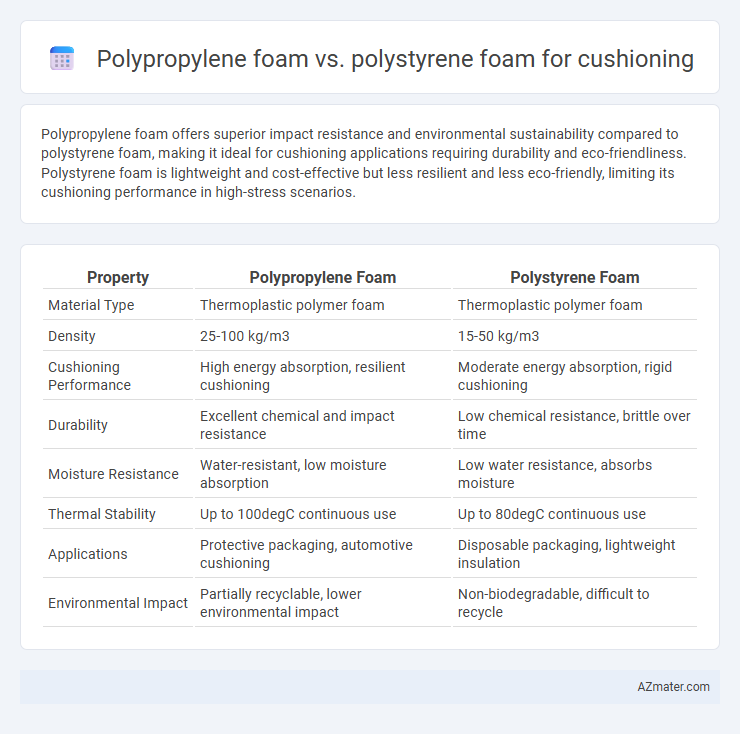Polypropylene foam offers superior impact resistance and environmental sustainability compared to polystyrene foam, making it ideal for cushioning applications requiring durability and eco-friendliness. Polystyrene foam is lightweight and cost-effective but less resilient and less eco-friendly, limiting its cushioning performance in high-stress scenarios.
Table of Comparison
| Property | Polypropylene Foam | Polystyrene Foam |
|---|---|---|
| Material Type | Thermoplastic polymer foam | Thermoplastic polymer foam |
| Density | 25-100 kg/m3 | 15-50 kg/m3 |
| Cushioning Performance | High energy absorption, resilient cushioning | Moderate energy absorption, rigid cushioning |
| Durability | Excellent chemical and impact resistance | Low chemical resistance, brittle over time |
| Moisture Resistance | Water-resistant, low moisture absorption | Low water resistance, absorbs moisture |
| Thermal Stability | Up to 100degC continuous use | Up to 80degC continuous use |
| Applications | Protective packaging, automotive cushioning | Disposable packaging, lightweight insulation |
| Environmental Impact | Partially recyclable, lower environmental impact | Non-biodegradable, difficult to recycle |
Introduction to Cushioning Foams
Polypropylene foam offers exceptional durability and high resistance to moisture, making it ideal for cushioning applications requiring lightweight yet strong support. Polystyrene foam provides excellent rigidity and impact absorption, commonly used in packaging where firm protection is essential. Both foams serve distinct cushioning needs, with polypropylene excelling in flexible comfort and polystyrene delivering structural stability.
Overview of Polypropylene Foam
Polypropylene foam offers superior durability and flexibility compared to polystyrene foam, making it an ideal material for cushioning applications requiring impact resistance and long-term performance. Its closed-cell structure provides excellent moisture resistance and thermal insulation, enhancing its protective qualities while maintaining lightweight properties. Widely used in automotive, packaging, and sports equipment industries, polypropylene foam ensures effective shock absorption and comfort in diverse environments.
Overview of Polystyrene Foam
Polystyrene foam, commonly used in cushioning applications, offers excellent rigidity and thermal insulation due to its closed-cell structure, making it highly effective for protecting fragile items during shipping. Its lightweight nature and resistance to moisture contribute to enhanced durability and cushioning performance, especially in packaging electronics and household goods. Compared to polypropylene foam, polystyrene foam tends to be less flexible but provides superior compressive strength and impact resistance for stable cushioning.
Physical Properties Comparison
Polypropylene foam exhibits greater impact resistance and flexibility compared to polystyrene foam, making it ideal for cushioning applications that require shock absorption and durability. Polystyrene foam possesses higher compressive strength and is more rigid, which provides excellent support but less resilience under repeated stress. The lower density and closed-cell structure of polypropylene foam contribute to superior water resistance and cushioning performance in dynamic environments.
Cushioning Performance and Shock Absorption
Polypropylene foam offers superior cushioning performance with higher resilience and flexibility, making it ideal for applications requiring consistent shock absorption and compression recovery. Polystyrene foam provides excellent rigidity and impact resistance but lacks the same level of cushioning comfort and energy return, often resulting in reduced shock absorption over time. The closed-cell structure of polypropylene foam enhances durability and vibration dampening, outperforming polystyrene foam in prolonged cushioning efficiency and protection.
Thermal and Chemical Resistance
Polypropylene foam demonstrates superior thermal resistance with a melting point around 160degC, making it ideal for cushioning applications exposed to moderate heat, while polystyrene foam melts at a lower temperature near 100degC. Chemically, polypropylene foam exhibits better resistance to solvents, oils, and chemicals, maintaining its cushioning properties under harsh environments, whereas polystyrene foam is more prone to degradation when exposed to hydrocarbons and certain chemicals. This makes polypropylene foam more durable and reliable in thermal and chemically challenging cushioning scenarios compared to polystyrene foam.
Environmental Impact and Recyclability
Polypropylene foam offers a lower environmental impact compared to polystyrene foam due to its higher recyclability and reduced carbon footprint during production. It is more easily recycled in existing municipal systems, which helps decrease landfill waste and supports circular economy initiatives. Polystyrene foam, while lightweight and effective for cushioning, is less biodegradable and presents challenges for recycling, leading to greater environmental persistence and pollution concerns.
Cost and Availability
Polypropylene foam generally offers a lower cost and higher availability compared to polystyrene foam, making it a preferred choice for budget-conscious cushioning applications. Its lightweight structure provides effective shock absorption while maintaining cost-efficiency in large-scale production and supply. Polystyrene foam, although widely available, tends to be more brittle and less durable, which can increase replacement costs and limit long-term use in cushioning solutions.
Common Applications in Cushioning
Polypropylene foam and polystyrene foam are commonly used in cushioning applications, with polypropylene foam favored for automotive seating and packaging due to its excellent resilience and vibration dampening properties. Polystyrene foam is widely used in protective packaging for electronics and fragile goods because of its rigid structure and superior impact absorption. Both materials provide effective cushioning but differ in flexibility and shock resistance, making them suitable for distinct cushioning needs.
Choosing the Right Foam for Your Needs
Polypropylene foam offers superior durability, chemical resistance, and flexibility, making it ideal for cushioning applications requiring long-term performance and repeated impact absorption. Polystyrene foam provides excellent rigidity and lightweight protection, suitable for packaging fragile items but less effective under compression or repeated stress. Selecting the right foam depends on specific cushioning needs, including load-bearing capacity, environmental exposure, and frequency of use.

Infographic: Polypropylene foam vs Polystyrene foam for Cushioning
 azmater.com
azmater.com